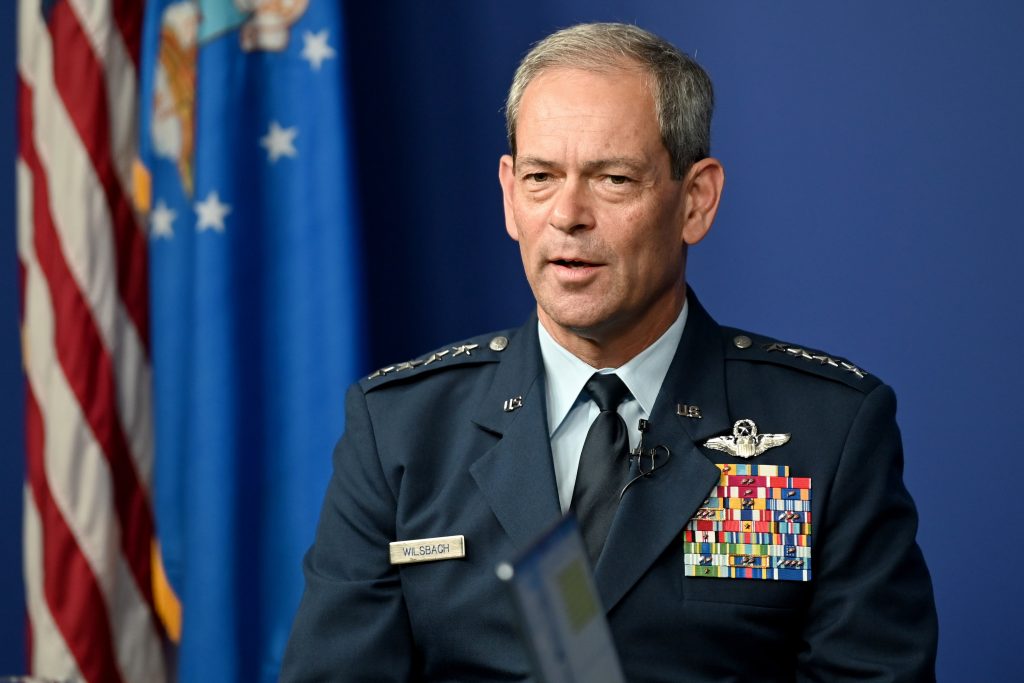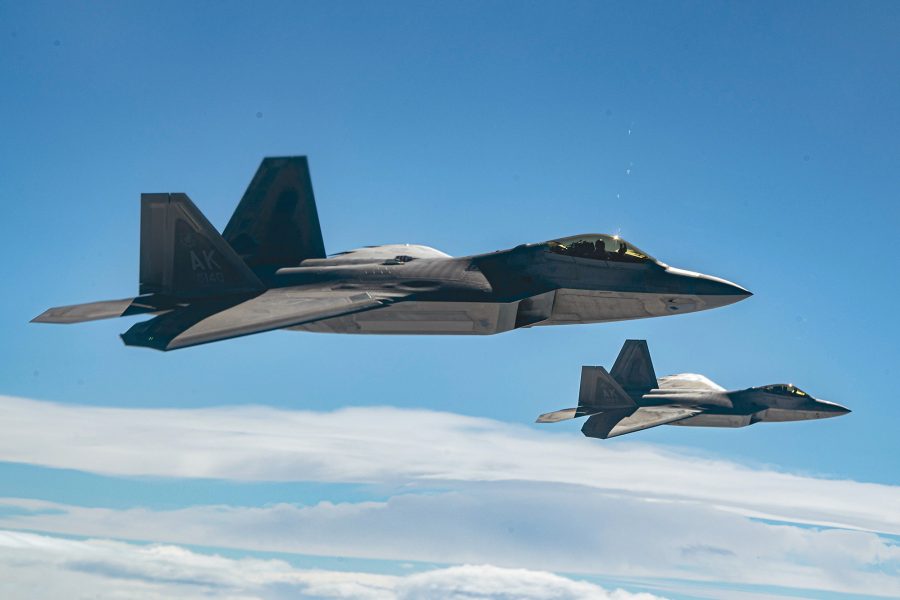Gen. Kenneth S. Wilsbach, head of Air Combat Command, came out in favor of retaining 32 Block 20 F-22 fighters, despite the fact that the Air Force has sought to retire the older jets in each of its last three budgets.
Speaking at the Mitchell Institute for Aerospace Studies on July 10, Wilsbach also said there is still no set replacement for the F-22. Taken together, it now appears clear the Air Force is likely to retain that aircraft into the next decade, contrary to earlier stated plans.
Wilsbach acknowledged ambiguity about the future of the Next-Generation Air Dominance (NGAD) fighter—a topic raised by senior leaders several times in recent weeks. He sees that as a key factor in why he believes the older F-22s shouldn’t be divested.
“I’m in favor of keeping the Block 20s,” he said. “They give us a lot of training value, and even if we had to—in an emergency—use the Block 20s in in a combat situation, they’re very capable.”
Air Force requests to divest the Block 20 aircraft, which have not been upgraded to the combat configuration applied to the rest of the fleet, have been repeatedly rebuffed by Congress. Air Force Secretary Frank Kendall has said it would cost upwards of $50 million each to raise them to that standard, and that the service has higher priorities for that money. USAF configured its last two budgets assuming it would not have to provide pilots or sustainment for those jets, but lawmakers, nervous about high-end fighter capacity, blocked any such divestments until fiscal 2028 at the earliest.
With the Air Force constrained in how many F-35s and F-15EX jets it can acquire, maintaining combat capacity has become a key issue for airpower advocates. Keeping the F-22s, whether upgraded or in their present Block 20 configuration, provides low-observable combat mass that cannot be acquired any other way until F-35 volumes increase, experts have stated.
As for the Next-Generation Air Dominance (NGAD), a family of systems now in development that would include manned and unmanned aircraft, Wilsbach said it is a mistake to see it as a “replacement” for the F-22.
“There isn’t an F-22 replacement,” he said. “The F-22 is fantastic aircraft. We’re actually planning several upgrades to the jet as we speak, and there is no official replacement to the F-22 right now.” Clarifying the point later, he explained: “There is no official F-22 replacement. There isn’t. Because we haven’t decided. … We haven’t done a source selection.”
Wilsbach said at the event that he still expects a choice to be made for an NGAD contractor this calendar year, confirming previously stated timelines.
He also said NGAD should be viewed as a “family of systems” and not a specific crewed airplane.
“I just want everybody to be clear that it’s a family of systems. And there’s a lot of things that are not in the public sphere that we’ve been working on for a while, and we’ll continue to expand that part of it, but I’ll just say it’s a family of systems, not one thing,” Wilsbach said.

The fiscal 2025 defense budget now making the rounds on Capitol Hill telegraphed that the Air Force may not retire the F-22 around 2030, as it said it would three years ago, claiming the fighter will soon no longer be able to outmatch Chinese J-20 stealth fighters.
The 2021 fighter force-defining plan called “4+1” by then-Chief of Staff Gen. Charles Q. Brown Jr. called for the fighter fleet to consist of:
- The F-22, giving way to NGAD circa 2030
- The F-35
- The F-15EX
- The F-16
- The A-10 was originally intended to be the “+1,” but rapid divestments mean that type will soon leave the fleet.
The 2025 budget, though, calls for more than $7 billion in improvements to the F-22 over the next five years—including new stealth wing tanks, infrared search-and-track systems and other upgrades—which makes little sense if the type is to be retired as soon as they are fielded. Air Force officials have said that those technologies would have applicability to NGAD, however.
The F-22 moves come as the government is still not accepting new F-35 fighters from contractor Lockheed Martin due to delays in testing for the new Tech Refresh 3 configuration.
Both the F-22 and NGAD “obviously will be in complement with the F-35, which we’re continuing to build,” said Wilsbach. “And hopefully, soon, we’ll start to take delivery of more of those as we get through the TR-3 slowdown at Lockheed Martin, and then, of course, the F-15EX.”
The F-35 international partners have agreed to accept a “truncated” version of the TR-3 hardware and software, and deliveries of nearly 100 aircraft that have been in storage are expected to resume imminently.
Wilsbach also said he recently declared Initial Operational Capability for the F-15EX. The updated Eagle will be “a tremendous platform for us because of its fourth-gen-plus capability and external weapons carriage,” Wilsbach added.
Some of the Air Force’s new long-range weapons, such as the Hypersonic Attack Cruise Missile, “can’t be carried on an F-35 or an F-22 because they don’t fit in the internal weapons bay,” but the EX “can carry some immense weapons that can go a long way. And so that F-15EX and F-15E will continue to be important platforms,” he said.
Meanwhile, the F-16 will continue to be “a good portion of our fighter force … and we’re continuing to upgrade those with new electronic warfare suites, and new electronically-scanned array antenna radars for them, so they can see much farther,” said Wilsbach.
“So the fleet that we have right now is in pretty good shape,” he added.
